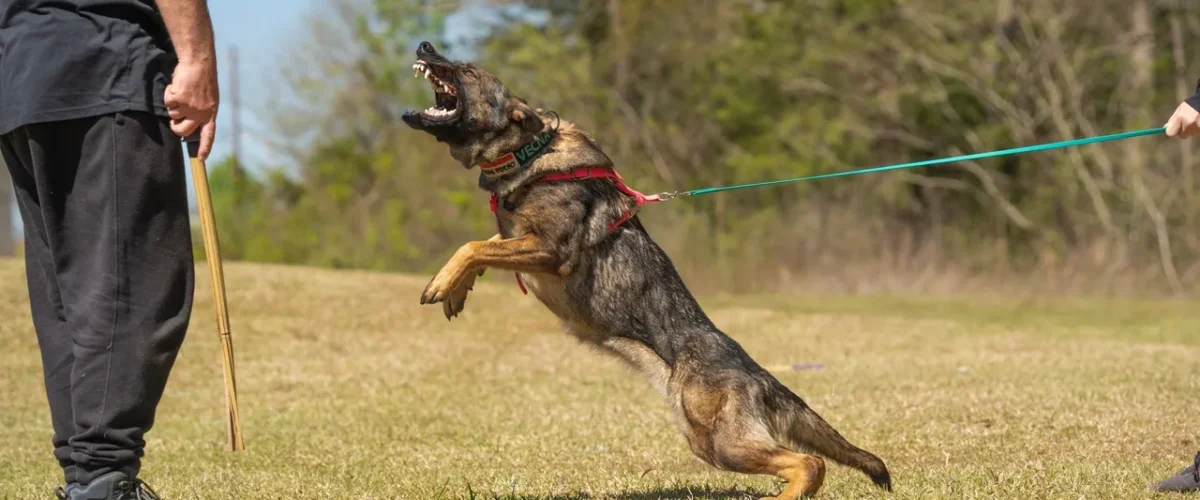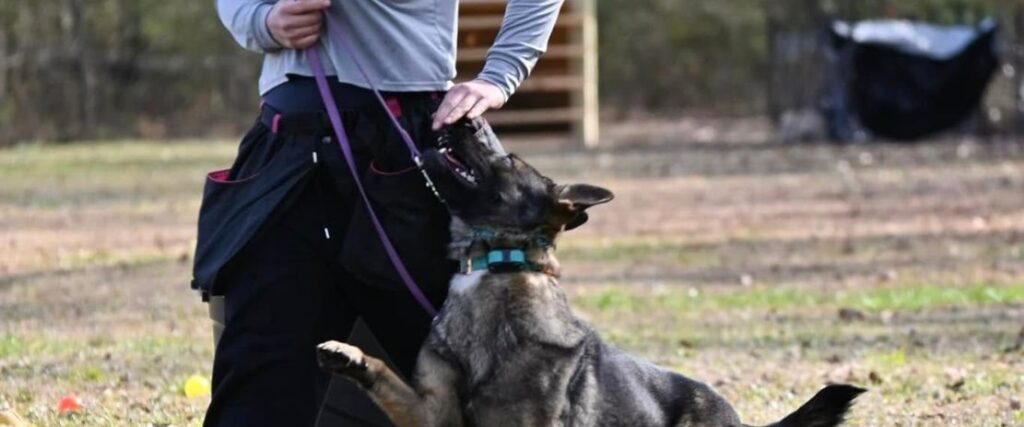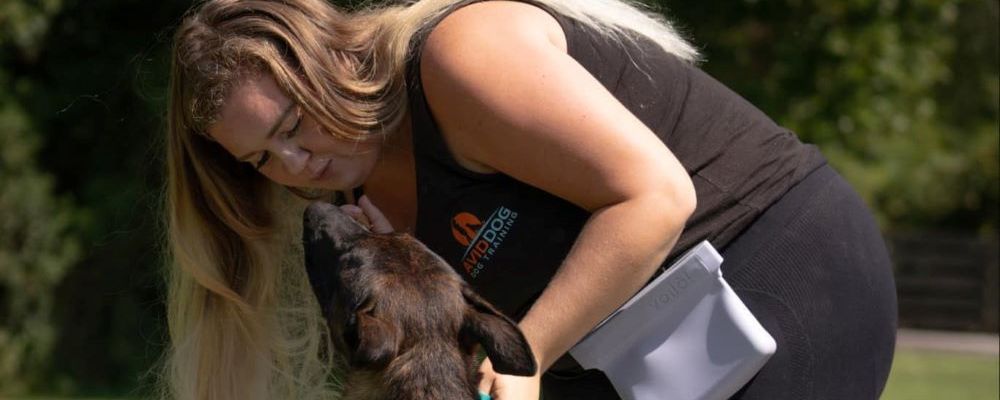One of the most common inquiries we get regarding training concerns reactive or aggressive behavior. Reactive or aggressive behavior can look like: growling, barking, lunging, snapping, and, of course, biting. This behavior may be directed towards other dogs, humans, small animals, livestock, etc.
Although it’s one of the most common issues, it can be difficult to diagnose and treat. Reactive or aggressive behavior in dogs is usually a symptom rather than the entire problem itself. Most dogs that show aggressive or reactive behavior have underlying issues such as insecurity, low confidence, fear, history of reinforcement, or genetics. Dog aggression training is crucial to understand and address the root causes of these behaviors effectively.
Why Professional Help is Crucial in Dog Aggression Training
It’s essential to hire a professional dog trainer to help diagnose the problem and create a tailored training plan. Aggression and reactivity training should never be “one size fits all.” If a trainer or anyone in your circle recommends using tools like e-collars, prong collars, or choke chains to correct behavior, it’s critical to seek additional guidance. This approach can make the situation worse.
Disclaimer: As with all online education, approach caution. Aggression and reactivity are multifaceted and nuanced, and self-implemented training techniques can often make things worse. For the best results, always hire a professional for an on-site assessment and guidance.
Understanding Different Types of Reactivity and Aggression in Dogs
Below, I’ve outlined different types of aggression and tips on how to understand or work through them. Keep in mind that every trainer’s approach to reactivity and aggression can vary. There is no fixed “scale” for diagnosing your dog’s reactive or aggressive behavior. However, the reasons listed below should help guide you and set you in the right direction.
1. Fear-Based Reactivity/Aggression
Fear-based aggression is, in my opinion, the root cause of 90% of aggression cases. This type of aggression usually stems from insecurity and low confidence, which can develop from genetics, negative experiences, or lack of socialization. Fear-based aggression starts with subtle signs like whale eye, lip licking, and growling. These early signs often go unnoticed or are mistakenly coddled, which may escalate into more overt aggressive behaviors.
How to Handle Fear-Based Aggression: The best approach is threshold training. Start by exposing your dog to the trigger at a distance and gradually move closer as your dog becomes more comfortable. This process can take time, so don’t rush it. The goal is to keep the dog below threshold and create positive associations, without accidentally reinforcing reactive or aggressive behaviors.
2. Leash Reactivity/Aggression
Leash reactivity is a common issue, often causing frustration that leads to reactive behavior resembling aggression. Interestingly, dogs with leash reactivity may not be aggressive towards others when off-leash.
How to Handle Leash Reactivity: The key is changing your dog’s association with the leash. Start training in a distraction-free environment and teach your dog to respond to leash pressure with calmness. Use positive reinforcement such as high-value treats when your dog responds appropriately to leash pops. It’s also crucial to work on engagement, showing your dog that YOU are the most important focus during walks.
Important Tip: Dogs with leash reactivity should not meet other dogs or people while on-leash until the behavior is fully managed. Allowing greetings while reactive can reinforce the problem.
3. Barrier Reactivity/Aggression
Barrier aggression occurs when a dog reacts aggressively while confined behind a fence, window, or in a kennel. It is usually caused by frustration, similar to leash reactivity.
How to Handle Barrier Reactivity: The first step is to prevent situations that lead to this behavior. Supervise your dog and intervene immediately when reactive behavior begins. Reward alternative behaviors using high-value food or toys.
4. Dominance Aggression
This type of aggression often occurs between same-sex dogs, with one attempting to assert dominance over the other. While some dogs naturally have dominant personalities, this behavior can lead to altercations.
How to Handle Dominance Aggression: Establish clear leadership in your household to prevent dominance struggles. Maintain a structured routine for your dog to avoid confusion or chaotic behavior.
Note: Spaying or neutering will not necessarily eliminate dominant behavior, especially in dogs with a history of aggressive tendencies. Control and structure are key.
5. Territorial Aggression
Certain breeds are genetically predisposed to territorial aggression, as they were originally bred for guarding. Dogs like Rottweilers, Dobermans, German Shepherds, and other livestock guardian breeds may show territorial behaviors.
How to Handle Territorial Aggression: Understanding your dog’s breed and its inherent traits is vital. Territorial aggression is managed similarly to barrier aggression but may require extra attention based on genetics. Make sure your dog’s temperament matches your lifestyle and expectations.
6. True Genetic Aggression
True genetic aggression is rare but exists in some breeds. If a dog’s lineage includes aggressive tendencies, the dog may display reactive behaviors around maturity (typically around 10 months of age).
How to Handle Genetic Aggression: Respect your dog’s boundaries. Not every dog needs to interact with other dogs to be happy. If you notice early signs of aggression, be cautious and avoid putting your dog in situations they’re not comfortable with.
7. Vet Check: An Essential Step
If your dog begins showing sudden, unexplained aggression or reactivity, it’s essential to consult a veterinarian. Physical or neurological issues, such as injuries, thyroid imbalances, or tumors, can sometimes cause changes in behavior.
Training Aggressive or Reactive Dogs
Dealing with aggression and reactivity in dogs can be tough, but with the right guidance, most dogs can learn to manage or overcome these behaviors. A professional dog trainer can help you understand what’s really going on and create a plan tailored to your dog’s specific needs. Every dog is different, and a personalized approach is key to lasting success.
If you’re feeling stuck or overwhelmed, you don’t have to figure this out alone.
Book a FREE consultation with AvidDog now. We offer expert dog aggression training in Wilmington, NC, and the surrounding areas. Let us help you get your dog’s behavior on track and bring peace back into your home.
FAQs: Aggressive and Reactive Dog Training
1. How can I tell if my dog is aggressive or reactive?
Aggression involves growling, snapping, or biting. Reactivity is barking, lunging, or pulling. Consult a professional if unsure.
2. Can aggressive behavior be fixed?
Yes, with proper training and consistent effort, aggression can be managed or reduced, depending on the cause.
3. How long will it take to correct aggressive behavior?
It varies, but improvements can take weeks to months, depending on the dog and severity of the behavior.
4. Can I handle fear-based aggression on my own?
It’s possible but not recommended. Professional guidance is crucial to avoid reinforcing aggression.
5. What tools should I avoid for aggressive dogs?
Avoid e-collars, prong collars, and choke chains. Use positive reinforcement methods instead.
Jenny Klamm, owner of AvidDog Dog Training, has been professionally providing dog training in Wilmington, NC, and surrounding areas since 2017. Passionate about ethical and effective training, she specializes in rehabilitating dogs with aggression, anxiety, and reactivity. Jenny helps dog owners build trusting bonds with their pets through compassionate training. Book your free consultation today! https://aviddogtraining.com/contact-us/.




